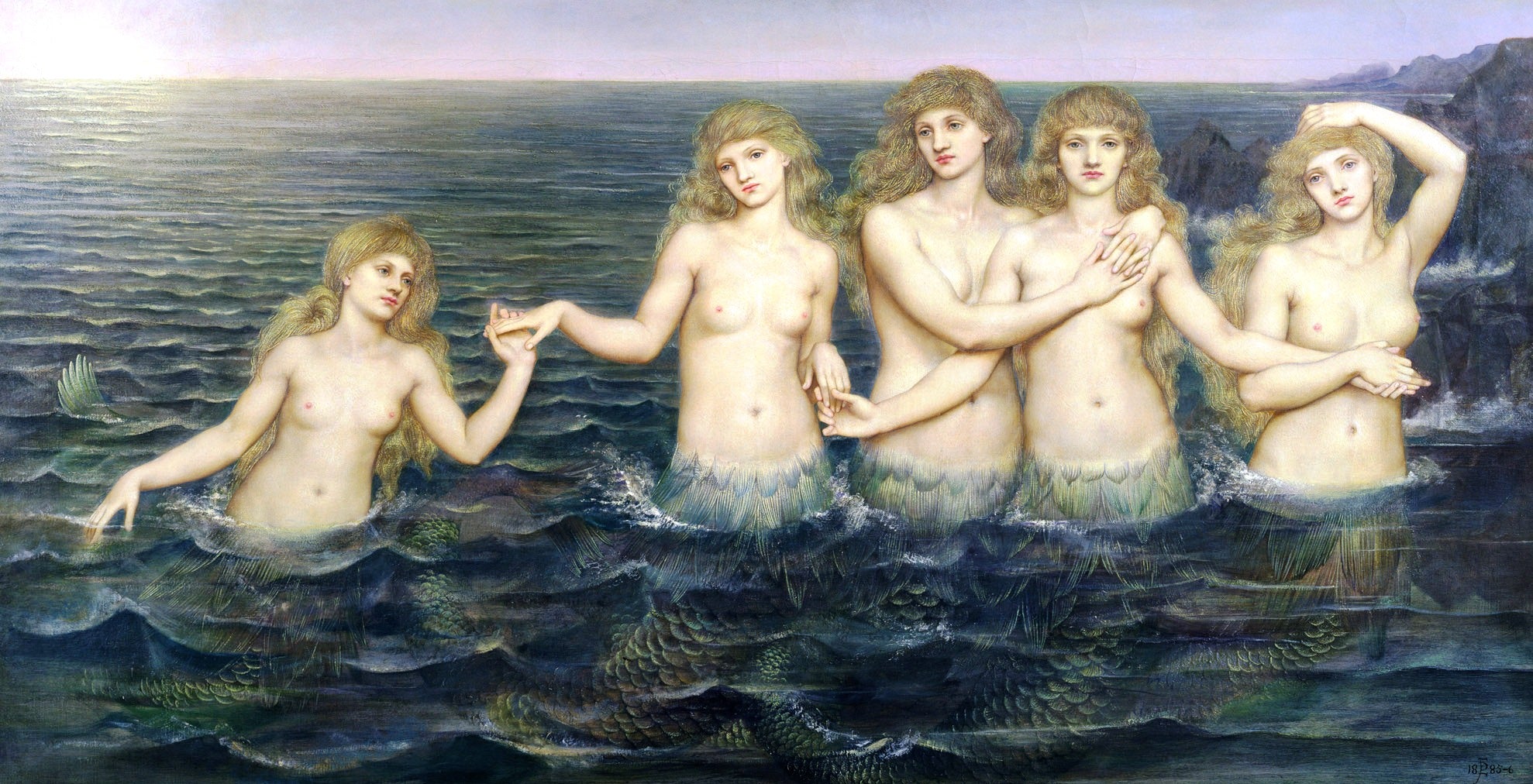Noah’s Arc, Albrecht Durer (1483)

This beautiful medieval painting comes from the Nuremberg Bible and was painted by Albrecht Durer. It features Noah’s vessel with many passengers and in the flood a family of merpeople. We can see a Siren combing her hair with a mirror, a merman floating to the right, and even a cute little merdog; see even mermaids have pets!
Even though they are not mentioned in the Bible we can see perpeople in this biblical art. With most of the land covered in water we can observe how Noah’s Arc has become a resting place for different species of birds, especially doves. You can also see the top of what seems to be huts or towers, we still aren’t sure, that have been partially submerged during the 40 day flood.
The Sea Maidens, Evelyn de Morgan (1886)

This allegorical painting was influenced by the Pre-Raphaelites, a group of English painters, and is currently hung in the Queen’s House in England. De Morgan used the same model for all five Sirens, Janes Hales.
It includes a group of Sirens with their tails underwater embracing each other and reaching to help a fifth one. This is a glaring depiction of sisterhood and feminine strength.
This piece is the first in a trilogy of paintings where female empowerment and the divine world meet. Unlike her contemporaries, de Morgan featured women in an imposing manner, never scared. She likes to tackle subjects like the patriarchy at her time, and the potential of women if they could be free
The Mermaid, Howard Pyle (1910)

This mysterious painting of a mermaid hugging his sailer lover under the moon was left unfinished by Howard Pyle in the US. He died one year later and the painting was finished by one of his students, Frank Schoonover, by adding some fish and a little crab to the scene.
The painting can be found in the Norman Rockwell Museum in Stockbridge, Massachusetts. You can admire how the blue moonlight reflects off both the Siren and sailor’s skin.
I’d like to know so much more about this story. Are they both reuniting after a long time apart, is it a sad goodbye, or is she saving him? I guess we’ll never know for sure…
The Village of the Mermaids, Paul Delvaux (1942)

At first glance this surrealist painting doesn’t include mermaids, but if you look carefully you can spot a group of mermaids about to dive into the water. You can also spot a mysterious man in a black coat at the end of the path.
This painting was inspired by a dream Delvaux had. If you notice all the women are wearing long dresses that cover up everything except their hands and head. The mermaids in the background are supposed to be the same women sitting down. In his dream the women take off their gowns and reveal their tails, setting themselves free into the sea.
Ulysses and the Sirens, Herbert James Draper (1909)

This oil painting is held in the Ferens Art Gallery in Hull, England. It depicts a famous scene from the epic poem, Odyssey, by Homer.
Circe warns Odysseus about singing Sirens that drive you mad and make you crash into the rocks in the already narrow passage. Odysseus convinces his sailors to stuff wax in their ears while he is tied to the mast going insane in the process.
In the original poem Sirens were depicted as half woman half bird like creatures, but Draper changed them to be more similar to the modern mermaid.
A Mermaid, John William Waterhouse (1900)

This painting was first exhibited at the Royal Academy in 1901. It might seem simple but given Waterhouse’s fascination of mermaids we can dig deeper. He was interested in the darker mythology of Sirens and their relationship with the human world.
In this painting he decides to depict the lonely world of a mermaid. The melancholic atmosphere serves to show how the mermaid is singing and combing her hair in sadness. There is also a bowl with some pearls which are believed to be tears from dead sailors with whom she’s tried to interact with.
In the Sea, Arnold Böcklin (1883)

Böcklin as a painter differed from Impressionists of his time. He’d rather depict mythical creatures in an odd and sensual manner.
In this painting a group of mermaids have attached to this triton playing the harp, one of them almost thrusting him. It also includes some weird large eared creatures to the right with their heads sticking out of the water. The painting gives us the impression that the mermaids are messing around with the triton while he seems to be in fear, or maybe just singing…
A Mermaid being mobbed by Seagulls, Giovanni Segantini (unknown)

We don’t know much about this painting, only that the author, Segantini, is well known for his paintings of the Alps. It seems that he went outside of his comfort zone to depict a mermaid being attacked by seagulls. She’s grabbing on to the legs of one of the birds as the others mob around her.
It is hard to definitively read the expression on her face. I don’t think she’s scared but has almost given up. Still it’s a beautiful underrated piece of art that we would love to know more about.
A Fisherman engulfed by a Siren, Knut Ekwall (1860s)

The only relevant ‘information’ we could find about this painting is a poem called Vortex of Desire. It explains how the Siren’ sexual desire makes her take the fisherman and pull him to the depths of the sea.
The fisherman has an expression in his faces that shows some fear, but not completely. His sexual desire seems to not make him completely deny the Siren’s presence and attempt to pull him into the water. This poem is not written by the author but is definitely an interesting take on this beautiful piece of art.
The Land Baby, John Collier (1899)

The mystery in this painting is amazing. We know the painter was a Pre-Raphaelite and that he was also a writer. We would love to know more about this painting.
Is it the first time this Siren sees a little girl or is this her daughter? The dress washed up on shore one might think is probably hers. The little girl seems to be happy but the Siren’s facial expression is not clear. We can’t see her face that well but we feel a vibe that somehow she knows this moment wont last long…
Something Else:

Etruscan bronze statuette representing a beautiful artistic interpretation, presumably of Scylla or another sea creature. Antiquarium of Corciano, Perugia, Italy; Origin: necropolis at Strozzacapponi, Italy, 7th century B.C.


Leave a comment